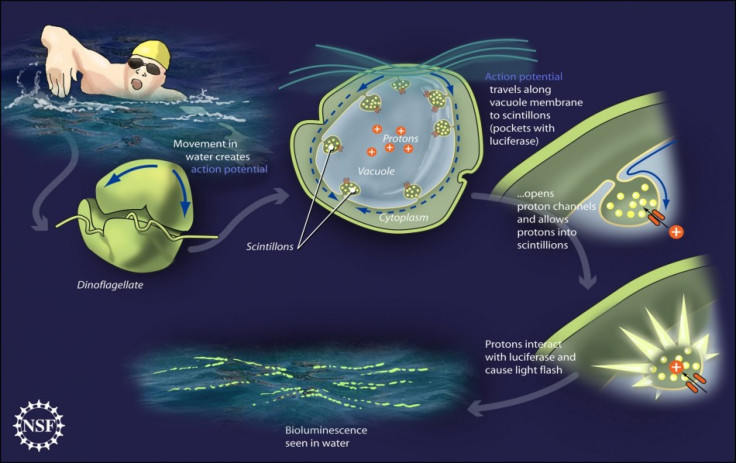Theory Emerges on Activation of 'Devlilish' Enzymes in Spooky Glow-In-The-Dark Plankton

Along the California coastline, it's occasionally possible to see an eerily breathtaking sight when the sun goes down: millions of flashes of bright blue lighting up the night as the surf meets the beach in an arresting, ethereal display. The phenomenon is caused by single-celled plankton called dinoflagellates, which periodically bloom in large numbers and emit light when disturbed. Scientists have long pondered the mechanism that allows for such electrifying visual displays but a recent hypothesis proposed by a team of led by Susan Smith of the Emory School of Medicine and Thomas DeCoursey of Rush University Medical Center is shedding light on one possible explanation.
The dinoflagellate's ability to put on these lightshows, they say, comes from the plankton's possession of voltage-activated gates within its cell that control the flow of protons from one part of the cell to another. J. Woodland Hastings, a member of the team, first proposed the existence these gates and the associated proton channels in a paper he coauthored with Margaret Fogel in 1972 entitled Bioluminescence: Mechanism and Mode of Control of Scintillon Activity.
The 2011 study, published in the journal Proceedings of the National Academy of Sciences, expanded on Fogel and Hastings' theory by examining the genes of another non-bioluminescent species of dinoflagellate, Karlodinium veneficum. They found that the plankton possesses a gene, kHv1, similar to the one that codes for voltage-gated proton channels found in humans, mice and sea squirts.
Voltage-gated proton channels are extremely versatile and, in humans, are involved in processes as varied as the release of histamine in white blood cells and in the maturation of sperm immediately before fertilization. Though in most vertebrates, the same proton channels are involved in digestion, Smith and DeCoursey suggest that they are responsible in bioluminescent flagellates with the activation of a particular enzyme that emits bursts of light.
According to Smith and DeCoursey's team, dinoflagellates are stimulated by movement in their environment, initiating the circulation of electrical impulses within a section of the cell called the vacuole, which contains protons. The electrical impulses trigger the opening of the proton channels, allowing protons to flow from the vacuole proper to pockets in its membrane called scintillons. The scintillons contain bioluminescent enzymes called luciferin and luciferase, named for the biblical fallen angel Lucifer, whose name means 'Light-bearer.' The protons activate the infernal enzymes, which produce tiny flashes of light that, when combined with the flashes of countless other dinoflagellates in a situation like a plankton bloom, result in sizable displays.
Recently, the dinoflagellates were caught on video along the San Diego shoreline:
Via the National Science Foundation.
© Copyright IBTimes 2024. All rights reserved.




















